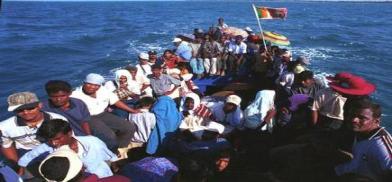A refugee problem in the making from crisis-hit Sri Lanka?
There is no quick fix for the dire problems Sri Lanka is facing as the crisis has been building up for over a decade now, signs of which were ignored by successive governments

The national inflation in Sri Lanka reached 17.5 percent in the last 12 months in February, The highest since October 2015 when the broader inflation gauge first started publishing the index; troops are stationed at fuel stations across the country; people are standing in long queues for hours to get even basic things like food and medicine—all these scenes made the news of the Indian Coast Guard rescuing 16 Sri Lankan Tamils fleeing the country to escape the mounting economic distress hardly surprising.
In the past too, Tamil Nadu, the southern coastal state in India, has been a natural refuge for fleeing Sri Lankans. During the three-decade-long civil war in Sri Lanka, Tamil Nadu, which has cultural, linguistic, and civilizational bonds with Sri Lankan Tamils, had become a second home for thousands of fleeing civilians.
Loose networks of smugglers ferrying people illegally across the sea between the two countries, still exist. These networks could expand, given the worsening crisis in Sri Lanka, as more and more people would be desperate to pay handsome amounts just to escape economic hardships.
Given the severity of economic crisis in Sri Lanka, India is likely to see more of such undocumented migrations from there, especially from the country’s Tamil-dominated north, a lesser developed region compared to the rest of Sri Lanka that has seen a lot of progress disparity between its dominant Sinhala and minority Tamil regions.
There is no quick fix for the dire problems Sri Lanka is facing as the crisis has been building up for over a decade now, signs of which were ignored by successive governments. The forex crisis is likely to continue for some months, a situation that President Gotabaya Rajapaksa, facing his three-year-old administration's stiffest challenge amid mounting social disquiet, warned in a recent speech.
The Sri Lankan rupee has fallen to nearly 265 against the US dollar; foreign reserves stood at $2.31 billion at the end of February. Sri Lanka must repay foreign debt totaling nearly $7 billion this year while the import bills alone are estimated to cross $22 billion against the estimated export earnings of around $12 billion.
The situation in the country is expected to aggravate, given the desperate measures like the electricity cuts— sometimes running up to 10 hours a day— and the strict import control measures that the government has put in place to manage import bills. However, all these measures will take a heavy toll on business and industry and shatter coveted dreams of turning Sri Lanka into a 'South Asian Singapore'.
External assistance from India—so far $2.4 billion this year— and China, and possibly from the IMF could only give breathing space to the island country. China has hinted that it is considering Colombo’s request for $2.5 billion assistance. However, the issue of restructuring of loans–a key demand of major importance from Sri Lanka— is yet to be taken up by Beijing.
The coming months would be extremely hard on Sri Lankans, a hint of which President Rajapaksa had already given in last week’s speech. He invoked past challenges like civil war and terrorism, seeking people’s forbearance to overcome the present situation.
For India, adopting extreme measures to stanch the refugee flow will not be an option, given its close political ties and cultural affinity with Sri Lanka and its people. But if the refugee trickle were to turn into a steadier flow, there might be political and social backlash that New Delhi will have to deal with.
(SAM)








Post a Comment